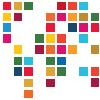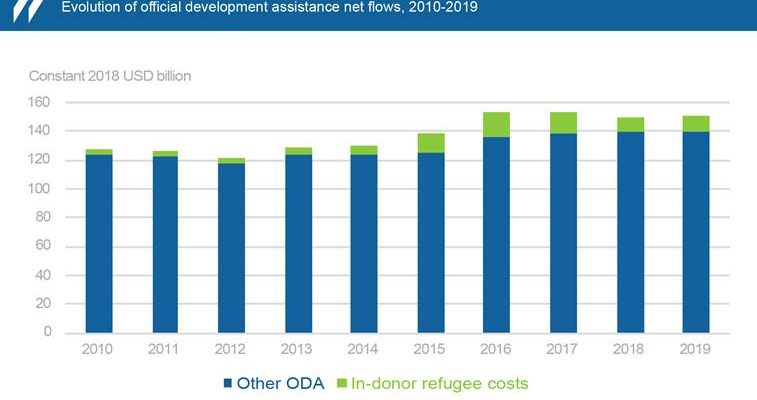Aktuelle Statistiken zur Entwicklungszusammenarbeit
Vorläufige Zahlen für 2019 zeigen einen Anstieg der öffentlichen Mittel für Entwicklungszusammenarbeit (ODA), insbesondere für die ärmsten Länder. Angesichts der Covid-19-Pandemie prüfen die OECD und die 30 Mitgliedsländer des OECD-Entwicklungshilfeausschusses (DAC) derzeit, wie über Entwicklungszusammenarbeit den am stärksten gefährdeten Ländern bei der Bewältigung der Krise am besten geholfen werden kann.
Den vorläufigen Zahlen zufolge haben die 30 DAC-Mitglieder in 2019 insgesamt 152,8 Milliarden US-Dollar für die Entwicklungszusammenarbeit bereitgestellt – ein Anstieg von 1,4% gegenüber dem Vorjahr. Achtzehn von ihnen erhöhten ihre Ausgaben, darunter insbesondere Österreich, Finnland, Griechenland, Ungarn, Japan, Korea, Norwegen und Slowenien. Auch in der Schweiz erhöhten sich die Ausgaben leicht (+0,6%). Elf Länder reduzierten ihre Mittel, darunter Polen, Portugal und Schweden. Auch in Deutschland sanken die Ausgaben leicht (-1,4%).
Unter folgenden Links finden Sie die jüngsten Zahlen und Erläuterungen im Detail:
Unter diesem Link lesen Sie das gemeinsame Statement der Länder im OECD-Entwicklungshilfeausschuss zur Covid-19-Krise vom 9. April 2020.
Untenstehend finden Sie darüber hinaus ausführliche Informationen auf Englisch.
OECD and donor countries working to focus development efforts on Covid-19 crisis, building on a rise in official aid in 2019
(Paris, 16 April 2020) – The OECD and member countries that provide foreign aid are exploring how they can work to help the most vulnerable countries to weather the Covid-19 crisis, as new data showed a rise in Official Development Assistance (ODA) in 2019, particularly to the poorest countries.
ODA from members of the OECD’s Development Assistance Committee (DAC) totalled USD 152.8 billion in 2019, a rise of 1.4% in real terms from 2018, according to preliminary data collected from official development agencies. Bilateral ODA to Africa and least-developed countries rose by 1.3% and 2.6% respectively. Excluding aid spent on looking after refugees within donor countries – which was down 2% from 2018 – ODA rose by 1.7% in real terms.
“This increase in the global development effort is an important first step, particularly as we now have an additional duty to step up support to those countries facing the harshest impacts of all from the coronavirus crisis,” said OECD Secretary-General Angel Gurría. “The response of development providers in the weeks and months ahead will be a critical force in the global battle against Covid-19. ODA has proved to be recession-proof in the past, including during the 2008 financial crisis, and I am confident it can be again.”
Total ODA in 2019 was equivalent to 0.30% of DAC countries’ combined gross national income, down from 0.31% in 2018 and below a target ratio of 0.7% of ODA to GNI. Five DAC members – Denmark, Luxembourg, Norway, Sweden and the United Kingdom – met or exceeded the 0.7% target (the same five countries as in 2018.) Among non-DAC donors, which are not counted in the DAC total, Turkey provided ODA equivalent to 1.15% of its GNI.
ODA rose in 18 DAC countries, with the largest increases in Austria, Finland, Greece, Hungary, Japan, Korea, Norway and Slovenia. It fell in 11 countries, most notably in Poland, Portugal and Sweden, in some cases because of lower spending on refugees. Net ODA has risen for the most part steadily in volume terms from just below USD 40 billion in 1960. Despite the 2008 crisis, ODA rose by 69% in real terms between 2000, when the Millennium Development Goals were agreed, and 2010, as donors committed to increases.
On April 9, the DAC issued a joint statement acknowledging the importance of ODA to help developing countries through the Covid-19 crisis, and saying members would “strive to protect” ODA budgets.
“It’s good news that ODA is increasing and that more of it is going to Africa and the poorest countries. We must build on this positive trend, because this global crisis demands strong global cooperation. Least developed countries will be the hardest hit by COVID-19. DAC members are already using ODA to help them respond to the double hit of health and economic crises. We will need to keep doing so throughout 2020 and beyond,” said DAC Chair Susanna Moorehead.
DAC members are sharing what they are doing to help developing countries combat the health crisis and economic fallout of the pandemic, with some donor countries already announcing reallocation of ODA money to support basic living conditions, build emergency health facilities and provide liquidity to developing country banks.
Mr. Gurría, in a joint statement with Mr. Achim Steiner, UN Development Programme Administrator, called on the international community and DAC members to act urgently to support those most vulnerable in the face of the crisis, including by increasing and sustaining ODA commitments. Ms Moorehead and OECD Development Co-operation Director Jorge Moreira da Silva urged DAC members to stand by their ODA commitments in March, to target efforts to health systems and vulnerable people and to ensure optimal coordination of humanitarian and development aid. To help them, the OECD is tracking the spread of Covid-19 in the world’s most fragile and insecure places on its States of Fragility platform.
The OECD is also working to analyse debt relief and other financial mechanisms for developing countries, donor support for women who make up the majority of health and care workers, support for global public goods – including research for new medicines or vaccines – and on longer-term analysis and guidance to help developing countries mitigate social and economic impacts. All official direct Covid19-related support to ODA-eligible countries, whether to invest in health systems or to protect and rebuild livelihoods will count as ODA.
Defined since 1969 as “government aid that promotes and specifically targets the economic development and welfare of developing countries”, ODA makes up over two thirds of external finance for least-developed countries. The OECD’s aid statistics track official flows from DAC donors. The OECD also monitors flows from some non-DAC providers and private foundations. Preliminary data each April is followed by final statistics at the end of each year with a detailed geographic and sectoral breakdown.
The 2019 total comprised USD 149.4 billion in the form of grants, loans to sovereign entities and contributions to multilateral institutions; USD 1.9 billion to development-oriented private sector instrument (PSI) vehicles, USD 1.4 billion in net loans and equities to private companies operating in ODA-eligible countries and USD 149 million of debt relief. Bilateral sovereign loans increased by 5.7% in real terms from 2018, suggesting some donors may be providing more concessional lending to low-income countries.
As in 2018, the 2019 data is expressed on a “grant equivalent” basis, offering a more realistic comparison between grants and loans, which account for around 17% of gross bilateral ODA, and a fairer measure of donor effort. Until 2018, loans were expressed on a “cash basis”, meaning their full face value was included then repayments were subtracted as they came in. The grant-equivalent methodology means only the “grant portion” of the loan, i.e. the amount “given” by lending below market rates, counts as ODA.
Links to aid data and background information:
- 2019 ODA statistics in detail
- 2019 ODA data tables
- More information on ODA (including Frequently Asked Questions, eligible countries, and all OECD aid data including charts on donors & recipients since 1960)

